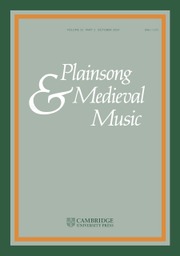Four articles in this first ‘themed’ volume of Plainsong and Medieval Music came into being in connection with the musicological research project ‘Chants that Bind and Break’ (CBB) at Trondheim University (Norway).Footnote 1 CBB is part of ‘Cultsymbols’, an international collaboration launched in 2010 under the aegis of the ‘Eurocores’ programme of the European Science Foundation, coordinated and led by Nils Holger Petersen (Copenhagen University). CBB cooperates with four other research teams based in Copenhagen (history of liturgy and ritual), Krems (art history), Tallinn and Budapest (medieval and early modern history).Footnote 2
The aim of ‘Cultsymbols’ is to investigate the significance of saints' cults in the context of regional and transregional identities, using the concept of cultural memory as the methodological framework.Footnote 3 The Trondheim subproject adds the perspective of musicology, examining the role of medieval plainchant in the articulation of identity, understood as an arc of values, ideas and ideals shared in varying degrees, and sometimes conflicting ways, by members of regional and/or transregional communities. CBB focuses on historiae – liturgical chant cycles composed in honour of saints. Produced widely across Europe from the ninth century on, historiae represent the main area of musical production connected with saints' cults.Footnote 4
Historia chants have been examined mainly from the perspectives of liturgy, poetry and/or musical style. Yet they also tell the stories of saints as historical figures, human beings active in this world, permitting us to look behind the ‘liturgical curtain’ at their creators' socio-political concepts.Footnote 5 In celebrating patron saints, historiae simultaneously express the self-worth, values and ideals of their communities.
Among the themes taken up in historiae, those involving war, violence and suffering are among the most significant. The contrast between violence and non-violence belongs to the identity of Christianity even from its Old Testament beginnings. In martyrs' legends, which often served as sources for historia texts, violence suffered is the gate to perfection, non-violence the saintly response to aggression. After their deaths, martyrs acted as helpers and even avengers in battle. Unprotected, Mother Church suffered; fully armed, she advanced to fight the heathens. Reflecting these contrasts, texts in historiae are full of drama and conflict, as the first article in this volume illustrates.
How does music figure in such considerations? Alerting us some thirty years ago to the potential for articulation vested in chant, Ritva Jonsson and Leo Treitler observed that a plainchant melody could be understood not only as a ‘reading of its text’, but also as a ‘record of its maker's responses to [the text]’, that is, its structure and message.Footnote 6 Scholarly contributions extending Jonsson and Treitler's ideas have been few,Footnote 7 so it appears timely to take up their line of inquiry, which the four articles in this issue approach from different perspectives. The first (Hankeln) outlines general thematic and analytic perspectives. The second (van Betteray) describes the phenomenon of melodic emphasis of thematically prominent text segments using the rhythmic evidence of eleventh-century St Gall neumes. The third contribution (Salvadó) pursues a similar line of inquiry, but with reference to historiae in Spanish sources, which due to their later dates do not provide information about rhythm and thus require a different analytic approach. The fourth (Petersen) asks the important question whether parallels exist between the themes and texts of Matins readings and responsories in the twelfth-century office of the Danish patron saint Canute Lavard.
With respect to the articulation of war, violence and suffering in historia chants, one cannot, of course, expect the bold musical imagery of later music. Emotionality is alien to the aesthetic of office chants, in part due to their liturgical–theological function. This does not, however, mean that the relationship between text and music was neutral. On the contrary, as all four articles underline, music and text clearly interact and this interaction often leads to an intensified representation of the texts.
Future studies may confirm, question or dispute the theses developed here, but absent a fully developed analytic methodology to account for the different levels of text–music interaction in plainchant, the contributors seek to revive and provoke conversation on a topic which has nearly been forgotten in musicological discourse. This neglect has led to a situation in which the messages of chant texts, and the significance of text–music interaction as a means of socio-political communication, often pass without comment. In a time when interdisciplinary research is key to the furtherance of knowledge in the Humanities, we believe this situation is in urgent need of address, not only by musicologists but also by scholars in related fields.


